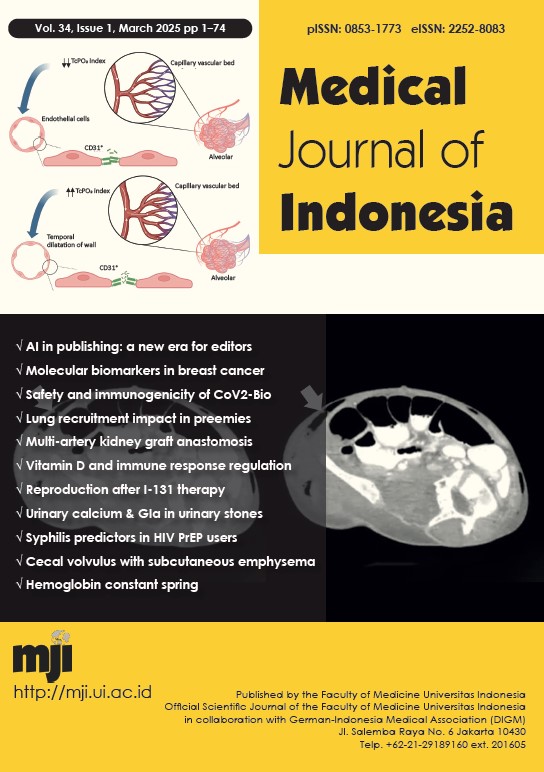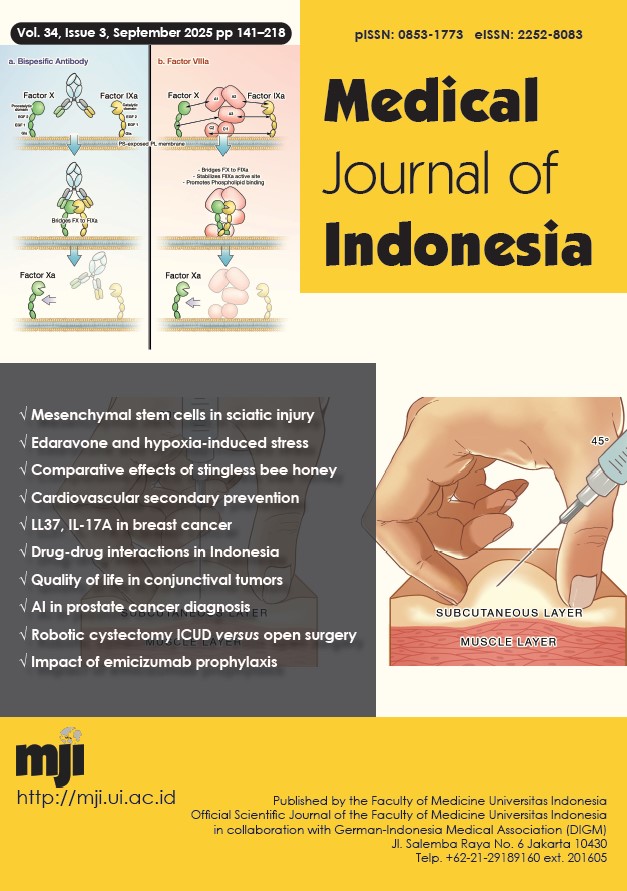Urinary calcium and matrix Gla protein levels in the kidney stones: a case-control study
DOI:
https://doi.org/10.13181/mji.oa.257748Keywords:
calcium, kidney stones, matrix Gla protein, nephrolithiasisAbstract
BACKGROUND Kidney stones are a global issue with varying prevalence. The most common metabolic risk factor is hypercalciuria, a condition where excess calcium in the urine promotes stone formation. Matrix Gla protein (MGP) inhibits stone formation by preventing crystal growth. This study aimed to analyze the correlation between urinary calcium and MGP levels in kidney stone formation.
METHODS A case-control study at Kardinah Hospital, Indonesia, included 64 patients with kidney stone and 64 healthy controls. Exclusion criteria included renal failure, stroke, kidney tumor, heart failure, and hemodialysis. Urinary calcium and MGP were measured using the 5’-nitro-5’-methyl-BAPTA method and enzyme-linked immunosorbent assay. Cut-off values were determined via receiver operating characteristic analysis.
RESULTS Among 128 participants (mean age: 51.6), the optimal cut-off for urinary MGP was 1,405 ng/l (p = 0.00024) with 62.5% sensitivity and 72% specificity. Urinary calcium cut-off was 72.5 mg/24 hours with 81.3% sensitivity and 62.5% specificity. Higher urinary calcium and MGP levels were linked to kidney stones (OR: 7.22; 95% CI: 3.23–16.18 and OR: 4.26; 95% CI: 2.03–8.96, respectively). A significant association was found between urinary calcium and MGP (OR: 5.11; 95% CI: 2.31–11.29, p = 0.00006) that hypercalciuria and increased MGP levels are predictors of kidney stone formation.
CONCLUSIONS Urinary calcium and MGP levels are associated with kidney stones. Elevated urinary calcium (>1,405 ng/l) increases MGP levels more than 5-fold. Depending on their levels, urinary calcium and MGP act as both promoters and inhibitors of stone formation.
Downloads
References
Albeshan SM, Mackey MG, Hossain SZ, Alfuraih AA, Brennan PC. Breast cancer epidemiology in gulf cooperation council countries: a regional and international comparison. Clin Breast Cancer. 2018;18(3):e381−92. https://doi.org/10.1016/j.clbc.2017.07.006
Coates AS, Winer EP, Goldhirsch A, Gelber RD, Gnant M, Piccart-Gebhart M, et al. Tailoring therapies--improving the management of early breast cancer: St Gallen International Expert Consensus on the Primary Therapy of Early Breast Cancer 2015. Ann Oncol. 2015;26(8):1533−46. https://doi.org/10.1093/annonc/mdv221
Olivotto IA, Bajdik CD, Ravdin PM, Speers CH, Coldman AJ, Norris BD, et al. Population-based validation of the prognostic model ADJUVANT! for early breast cancer. J Clin Oncol. 2005;23(12):2716−25. https://doi.org/10.1200/JCO.2005.06.178
Wishart GC, Bajdik CD, Dicks E, Provenzano E, Schmidt MK, Sherman M, et al. PREDICT Plus: development and validation of a prognostic model for early breast cancer that includes HER2. Br J Cancer. 2012;107(5):800−7. https://doi.org/10.1016/j.ejso.2012.02.027
Oh DY, Bang YJ. HER2-targeted therapies - a role beyond breast cancer. Nat Rev Clin Oncol. 2020;17(1):33−48. https://doi.org/10.1038/s41571-019-0268-3
Waks AG, Winer EP. Breast cancer treatment: a review. JAMA. 2019;321(3):288−300. https://doi.org/10.1001/jama.2018.19323
Cardoso F, van't Veer LJ, Bogaerts J, Slaets L, Viale G, Delaloge S, et al. 70-gene signature as an aid to treatment decisions in early-stage breast cancer. N Engl J Med. 2016;375(8):717−29. https://doi.org/10.1056/NEJMoa1602253
Teng F, Xu Z, Chen J, Zheng G, Zheng G, Lv H, et al. DUSP1 induces apatinib resistance by activating the MAPK pathway in gastric cancer. Oncol Rep. 2018;40(3):1203−22. https://doi.org/10.3892/or.2018.6520
Braicu C, Buse M, Busuioc C, Drula R, Gulei D, Raduly L, et al. A comprehensive review on MAPK: a promising therapeutic target in cancer. Cancers (Basel). 2019;11(10):1618. https://doi.org/10.3390/cancers11101618
Wang J, Zhou JY, Kho D, Reiners JJ Jr, Wu GS. Role for DUSP1 (dual-specificity protein phosphatase 1) in the regulation of autophagy. Autophagy. 2016;12(10):1791−803. https://doi.org/10.1080/15548627.2016.1203483
Goel S, Saheb Sharif-Askari F, Saheb Sharif Askari N, Madkhana B, Alwaa AM, Mahboub B, et al. SARS-CoV-2 switches 'on' MAPK and NFκB signaling via the reduction of nuclear DUSP1 and DUSP5 expression. Front Pharmacol. 2021;12:631879. https://doi.org/10.3389/fphar.2021.631879
Sanders BE, Yamamoto TM, McMellen A, Woodruff ER, Berning A, Post MD, et al. Targeting DUSP activity as a treatment for high-grade serous ovarian carcinoma. Mol Cancer Ther. 2022;21(8):1285−95. https://doi.org/10.1158/1535-7163.MCT-21-0682
Celaya AM, Sánchez-Pérez I, Bermúdez-Muñoz JM, Rodríguez-de la Rosa L, Pintado-Berninches L, Perona R, et al. Deficit of mitogen-activated protein kinase phosphatase 1 (DUSP1) accelerates progressive hearing loss. Elife. 2019;8:e39159. https://doi.org/10.7554/eLife.39159
Kumar P, Bhandari N. lncRNAs: role in regulation of gene expression. Gene Expression. IntechOpen; 2022. https://doi.org/10.5772/intechopen.104900
Liu SJ, Dang HX, Lim DA, Feng FY, Maher CA. Long noncoding RNAs in cancer metastasis. Nat Rev Cancer. 2021;21(7):446−60. https://doi.org/10.1038/s41568-021-00353-1
Sun M, Wu D, Zhou K, Li H, Gong X, Wei Q, et al. An eight-lncRNA signature predicts survival of breast cancer patients: a comprehensive study based on weighted gene co-expression network analysis and competing endogenous RNA network. Breast Cancer Res Treat. 2019;175(1):59−75. https://doi.org/10.1007/s10549-019-05147-6
Zheng YL, Li L, Jia YX, Zhang BZ, Li JC, Zhu YH, et al. LINC01554-mediated glucose metabolism reprogramming suppresses tumorigenicity in hepatocellular carcinoma via downregulating PKM2 expression and inhibiting Akt/mTOR signaling pathway. Theranostics. 2019;9(3):796−810. https://doi.org/10.7150/thno.28992
Schurch NJ, Schofield P, Gierliński M, Cole C, Sherstnev A, Singh V, et al. How many biological replicates are needed in an RNA-seq experiment and which differential expression tool should you use? RNA. 2016;22(6):839−51. Erratum in: RNA. 2016;22(10):1641. https://doi.org/10.1261/rna.053959.115
Raju GS, Pavitra E, Bandaru SS, Varaprasad GL, Nagaraju GP, Malla RR, et al. HOTAIR: a potential metastatic, drug-resistant and prognostic regulator of breast cancer. Mol Cancer. 2023;22(65). https://doi.org/10.1186/s12943-023-01765-3
Chen Z, Chen Q, Cheng Z, Gu J, Feng W, Lei T, et al. Long non-coding RNA CASC9 promotes gefitinib resistance in NSCLC by epigenetic repression of DUSP1. Cell Death Dis. 2020;11(10):858. https://doi.org/10.1038/s41419-020-03047-y
Peng W, Zhang C, Peng J, Huang Y, Peng C, Tan Y, et al. Lnc-FAM84B-4 acts as an oncogenic lncRNA by interacting with protein hnRNPK to restrain MAPK phosphatases-DUSP1 expression. Cancer Lett. 2020;494:94−106. https://doi.org/10.1016/j.canlet.2020.08.036
Pan S, Shen M, Zhou M, Shi X, He R, Yin T, et al. Long noncoding RNA LINC01111 suppresses pancreatic cancer aggressiveness by regulating DUSP1 expression via microRNA-3924. Cell Death Dis. 2019;10(12):883. https://doi.org/10.1038/s41419-019-2123-y
Li L, Huang K, Lu Z, Zhao H, Li H, Ye Q, et al. Bioinformatics analysis of LINC01554 and its co‑expressed genes in hepatocellular carcinoma. Oncol Rep. 2020;44(5):2185−97. https://doi.org/10.3892/or.2020.7779
Martínez-Martínez D, Toledo Lobo MV, Baquero P, Ropero S, Angulo JC, Chiloeches A, et al. Downregulation of snail by DUSP1 impairs cell migration and invasion through the inactivation of JNK and ERK and is useful as a predictive factor in the prognosis of prostate cancer. Cancers (Basel). 2021;13(5):1158. https://doi.org/10.3390/cancers13051158
Lee S, Hwang Y, Kim TH, Jeong J, Choi D, Hwang J. UPF1 inhibits hepatocellular carcinoma growth through DUSP1/p53 signal pathway. Biomedicines. 2022;10(4):793. https://doi.org/10.3390/biomedicines10040793
Sheng J, Li H, Dai Q, Lu C, Xu M, Zhang J, et al. DUSP1 recuses diabetic nephropathy via repressing JNK-Mff-mitochondrial fission pathways. J Cell Physiol. 2019;234(3):3043−57. https://doi.org/10.1002/jcp.27124
Published
How to Cite
Issue
Section
License
Copyright (c) 2025 Zulfikar Ali, Fradelino Esau Selanno, I Putu Gde Fredy Gunawan, Mohammad Sulchan, Ponco Birowo, Tri Indah Winarni

This work is licensed under a Creative Commons Attribution-NonCommercial 4.0 International License.
Authors who publish with Medical Journal of Indonesia agree to the following terms:
- Authors retain copyright and grant Medical Journal of Indonesia right of first publication with the work simultaneously licensed under a Creative Commons Attribution-NonCommercial License that allows others to remix, adapt, build upon the work non-commercially with an acknowledgment of the work’s authorship and initial publication in Medical Journal of Indonesia.
- Authors are permitted to copy and redistribute the journal's published version of the work non-commercially (e.g., post it to an institutional repository or publish it in a book), with an acknowledgment of its initial publication in Medical Journal of Indonesia.




































